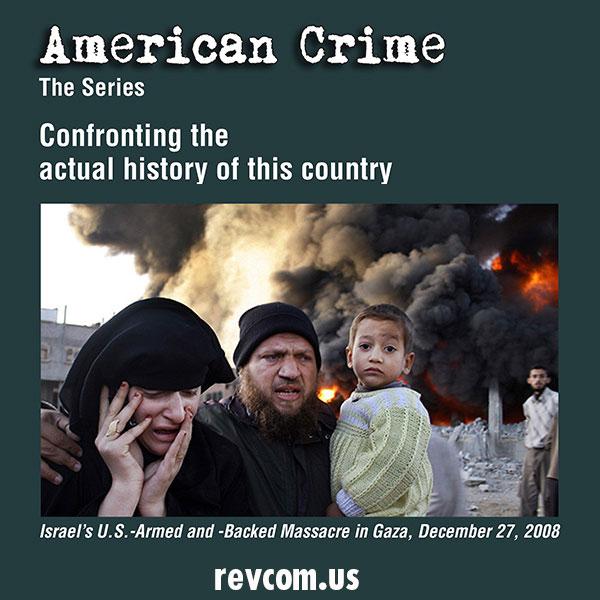Bob Avakian has written that one of three things that has “to happen in order for there to be real and lasting change for the better: People have to fully confront the actual history of this country and its role in the world up to today, and the terrible consequences of this.” (See “3 Things that have to happen in order for there to be real and lasting change for the better.”)
In that light, and in that spirit, “American Crime” is a regular feature of revcom.us. Each installment focuses on one of the 100 worst crimes committed by the U.S. rulers—out of countless bloody crimes they have carried out against people around the world, from the founding of the U.S. to the present day.
See all the articles in this series.
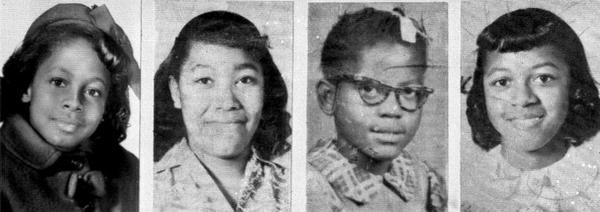
Four young girls who were killed when a bomb—set by the KKK— exploded before Sunday morning services at the 16th Street Baptist Church in Birmingham, Alabama, September 15, 1963. Denise McNair, Carole Robertson, Addie Mae Collins, and Cynthia Wesley.
THE CRIME
On September 15, 1963, a bomb exploded before Sunday morning services at the 16th Street Baptist Church in Birmingham, Alabama. The bomb was set by local members of the Ku Klux Klan (KKK). Four young girls were killed and 20 others injured.
In the moments just before the murders, the girls chatted happily and straightened their fancy white dresses. It was Youth Day and excitement filled the air; they were going to take part in the Sunday adult service. Addie Mae Collins, 14, and Denise McNair, 11, were preparing to sing in the church choir. Carole Robertson and Cynthia Wesley—both 14—were going to be ushers. Addie Mae was helping Denise tie the sash on her dress. But before she could finish, the bomb went off. Minutes before 11 o’clock, the congregation was knocked to the ground. As the bomb exploded under the steps of the church, the worshippers sought safety under the pews and shielded each other from falling debris. In the basement the four girls were killed. Sarah Collins, Addie’s sister, survived, but lost an eye in the bombing.
Outrage over the incident and the violent clash that followed between people protesting the bombing and police trying to suppress them drew national attention to the hard-fought, often dangerous struggle for justice for African-Americans, which not only continued over the next decades, but also has intensified in many ways. Two more young African-Americans died in the protests, and eventually the National Guard was called in to “restore order.”
The bombing of the 16th Street Baptist Church on September 15, 1963, was the third bombing in 11 days, after a federal court order had come down mandating the integration of Alabama’s school system.
Upon learning of the bombing at the church, Reverend Martin Luther King Jr. sent a telegram to Alabama governor George Wallace, a staunch and vocal segregationist, stating bluntly: “The blood of our little children is on your hands.” The brutal attack and the deaths of the four girls shocked the nation and drew international attention to the violent struggle for civil rights in Birmingham. Many whites were as outraged by the incident as Black people were and offered services and condolences to the families. More than 8,000 people attended the girls’ funeral service at Reverend John Porter’s Sixth Avenue Baptist Church.

In the months before the 16th Street Baptist Church bombing, Birmingham had become the focal point of the civil rights struggle. Above: Police lead a group of Black school children to jail after their arrest for protesting against racial discrimination near city hall in Birmingham, May 1963. Below: Firefighters turn their hoses full force on civil rights demonstrators July 15, 1963. Photos: AP
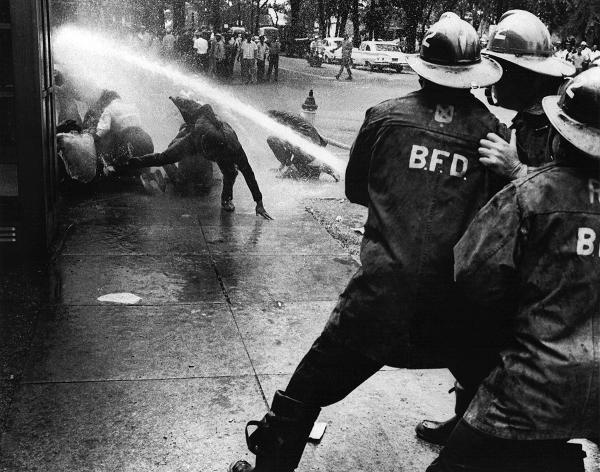
Racial Injustice in Birmingham and the Country in 1963
Throughout the civil rights movement of the 1950s and ’60s, Birmingham was a major site of protests, marches, and sit-ins that were often met with police brutality and violence from white citizens. Homemade bombs planted by white supremacists in homes and churches became so commonplace that the city was sometimes known as “Bombingham.”
In the months leading up to the 16th Street Baptist Church bombing, Birmingham had become the focal point of the civil rights struggle. The city was all too familiar with racial violence. Both African-Americans and moderate whites had been long terrorized by the KKK.
Years earlier, Birmingham minister Fred L. Shuttlesworth founded the Alabama Christian Movement for Human Rights (ACMHR) to directly confront racism and segregation in the city. In the spring of 1963, Shuttlesworth’s group joined forces with Dr. Martin Luther King Jr., and his Southern Christian Leadership Conference (SCLC), the largest and best known organization fighting for equal rights at the time. Together, the men formulated a plan that called for months-long protests to end segregation in Birmingham.
In May of that year, after weeks of marches, sit-ins, boycotts, bus strikes, and prayer vigils by the Black community, an agreement was reached between local government leaders, white business owners, African-American leaders, and civil rights groups. The city would now actively begin working toward integration. The agreement did not sit well with segregationists, among the most violent of which was the notorious KKK.
Riots erupted during the summer months, and nightly newscasts revealed to the rest of America the lengths to which Southern racists like Governor George Wallace and Birmingham’s Commissioner of Public Safety, Eugene “Bull” Connor, would go in their fight to keep the South segregated.
Why This Church?
16th Street Baptist was a large and prominent church located downtown, just blocks from Birmingham’s commercial district and City Hall. Since its construction in 1911, the church had served as the centerpiece of the city’s African-American community, a social center and lecture hall that also served as a meeting place for civil rights leaders. Because of its size, location, and importance to the community, the church served as headquarters for civil rights mass meetings and rallies in the early 1960s.
KKK members had routinely called in bomb threats intended to disrupt civil rights meetings as well as services at the church. In April 1963, Birmingham was the most segregated city in the United States. Precisely because of its reputation as a stronghold for white supremacy, white supremacists responded with violence to Birmingham’s reckoning on racial injustice. The Klansmen who planted the bomb wanted to terrorize the Black community and maintain white supremacy at a moment when legal segregation was under assault in the country.
Justice Never Fulfilled
The FBI office in Birmingham launched an immediate investigation, but it took until 1965 for the head of the FBI in Birmingham to write a memo to J. Edgar Hoover naming four men—Thomas Blanton, Robert Chambliss, Bobby Frank Cherry, and Herman Cash—as primary suspects in the bombing. The investigation ended in 1968 with no indictments. Although Chambliss was convicted on an explosives charge, no charges were filed in the 1960s for the bombing of the church.
In 1971, Alabama’s newly elected attorney general, Bill Baxley, reopened the case, requesting evidence from the FBI and building trust with witnesses who had been reluctant to testify. Investigators discovered that, while the FBI had accumulated evidence against the bombers, under orders from Hoover they had not disclosed the evidence to county prosecutors and no one was indicted. Robert Chambliss was convicted of murder on November 14, 1977; however, it would be decades before the other suspects were tried for their crimes. Herman Cash died in 1994 having never been prosecuted for the murders of the four girls.
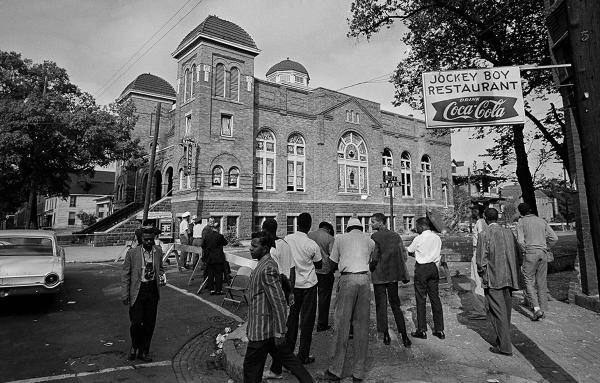
The scene outside the 16th Street Baptist Church a few days after the bombing. Alabama Gov. Wallace sent police and state troopers to break up protests that had broken out. Photo: AP
THE CRIMINALS
The KKK: Thomas Blanton, Robert Chambliss, Bobby Frank Cherry, and Herman Cash. All four men were members of East Birmingham’s Cahaba River Bridge Boys, a splinter group of the Eastview Klavern #13 chapter of the Ku Klux Klan.
George Wallace, then Alabama governor, an outspoken segregationist, declared at his January 1963 inauguration: “segregation now, segregation tomorrow and segregation forever,” and created the climate that led to the killings. Then one week before the bombing, Wallace granted an interview with the New York Times, in which he said he believed Alabama needed a “few first-class funerals” to stop racial integration. Wallace was a leading foe of desegregation, and Birmingham had one of the strongest and most violent chapters of the Ku Klux Klan (KKK) with his support. Wallace built his entire political career on white supremacy and segregation and was elected four times as Alabama’s governor. After the 16th Street Baptist Church bombing, Governor Wallace sent the police and state troopers to break up the righteously angry protesters. In the clash that followed, protesters did not back down -- many were arrested and two young African-American men were killed. The National Guard was then sent to suppress the protests.
Eugene “Bull” Connor, the city’s police commissioner, a Southern Democrat, was a staunch proponent of racist social policies and was notorious for his willingness to use brutality in combating radical demonstrators, union members, and Black citizens. Connor, in charge of the police and firemen of the city, supported the Ku Klux Klan when they attacked Black freedom fighters.
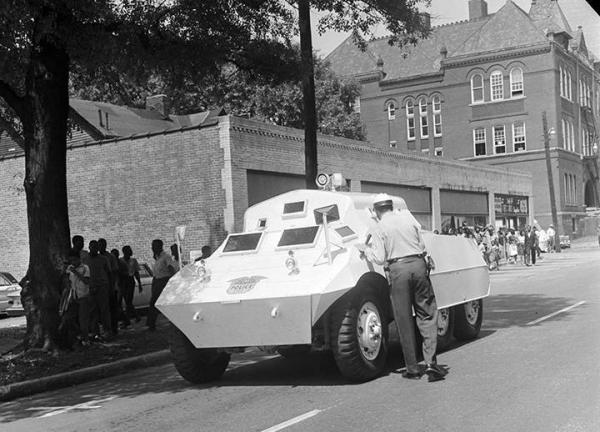
An armored riot car, used by Birmingham Police Department. The riot cars were used for intimidation, with Connor himself often riding along on patrols through Black neighborhoods. They were also dispatched to scenes of protest during the Civil Rights Movement. Photo: Ed Jones
In the spring of 1963, Connor’s all-white fire and police departments grew increasingly anxious over this Black presence in Birmingham’s streets and arrested King and other Black leaders. During the first week of May, Connor ordered the use of high-pressure fire hoses and police dogs against the demonstrators, and even deployed a police department armored tank. The familiar images of these encounters erased once and for all Birmingham’s image as the “Pittsburgh of the South.”
J. Edgar Hoover, the head of FBI. In spite of being informed of the four suspects of the bombing in 1965, Hoover formally blocked any impending federal prosecutions against the suspects, and refused to disclose any evidence his agents had obtained to state or federal prosecutors. In 1968, the FBI formally closed their investigation into the bombing without filing charges against any of their named suspects. The files were sealed by order of Hoover.

THE ALIBI
When Hoover faced people seeking justice in the murders, he justified the FBI’s inaction saying, “The chance of prosecution in state or federal court is remote.”
THE ACTUAL MOTIVE
Between 1525 and 1866, 12.5 million people were kidnapped from Africa and sent to the Americas through the transatlantic slave trade. Only 10.7 million survived the harrowing two-month journey.
African-Americans have endured centuries of enslavement, exploitation, and inequality. Whenever they stood against cruelty and demanded justice, they faced oppressive countermeasures of white supremacist and racist Americans in the most brutal and violent form.
The immense brutality carried out against enslaved individuals in their everyday lives is vividly reflected in the so-called proud history of this United States. The bombing of the Birmingham 16th Street Baptist Church is a case in point of this cruelty, where little girls were knowingly bombed and then the crowd enraged by this heinous murder was silenced by the force of the National Guard. The murderers escaped justice for a long time. The FBI, Alabama’s governor, and its state attorney general turned a blind eye to the terroristic act, and the perpetrators and all the institutions in charge evaded responsibility.
Racial, economic, and educational disparities are deeply entrenched in U.S. institutions. Although the Declaration of Independence states that “all men are created equal,” American democracy has historically—and often violently—excluded certain groups. Systematic racism is deeply rooted in American society and the future of racism in this system looks bleak.
References
Birmingham Church Bombing, History.com editors, updated January 25, 2021
“158 Resources to Understand Racism in America,” Meilan Solly, Smithsonian magazine, June 4, 2020
“16th Street Baptist Church bombing,” Chelsey Parrott-Sheffer, Britannica.com, July 30, 2009
“Four Girls Forever Lost: 57 years ago, 16th Street Baptist Church bombing awakened nation to deadly consequences of hate,” Tafeni English, Southern Poverty Law Center, September 15, 2020.
“4 Little Girls Died In The 16th Street Baptist Church Bombing In 1963. A 5th Survived,” WBUR.org, April 30, 2019
America Sees the Truth, an account of the 16th Street Bombing, blog post at National Museum of African American History & Culture, Smithsonian
Eugene “Bull” Connor, Biography.com

